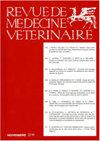Vigilancia de las agresiones causadas por animales susceptibles a rabia, una lesión de causa externa evitable, Casanare-Colombia, 2012-2016
Q2 Veterinary
引用次数: 0
Abstract
Surveillance, prevention and control of the rabies are a priority in public health, especially when it is transmitted by dogs (variant 1) and by wild animals. This research intended to describe the epidemiological behavior of these events during 2012-2016 in the Casanare Province (Colombia). It is a retrospective descriptive study based on the cases reported to the National Surveillance System for Public Health Sivigila . The study variables are: a) socio-demographics; b) aggression/contact; c) exposure; d) immunization; and e) treatment. Application of descriptive statistics and calculation of surveillance indicators: Data were analyzed using the statistical software Epithe cases in Casanare were distributed as follows: 2012 (1229; 20.4%), 2013 (1180;19.5%), 2014 (1227; 20.3%); 2015 (1153;19.1%), 2016 (1247; 20.7%). Out of them 72.5% were in the urban area; 55.4% were male subjects; average age was 24.3 (± 20.7) being the lowest age 0.01 and the highest 97 years and 40.7% were in the 5-19-year range; 37.5% were students, 13.3% housewives, 5.4% minors, and 19.4% had reported occupation (to wit, 29.8% (349/1172) farmers; 1.5% hospital patients; all of them alive). The 80.6% (721/894) with mild exposure were appropriately treated, 4.3% (37/894) were administered anti-rabies serum. The 91.1% (653/717) with serious exposure were appropriately treated. The 26.7% (1611/6036) of the cases were exposed to the rabies virus. Incidence per each 100,000 inhabitants exposed to the rabies was as follows: 2012-2016, 344.8 cases; hospitalization rate 11.5/100,000. It was found a non-compliance with the appropriate treatment indicator, i.e., the cases rated as mild exposure required administering only five doses of rabies vaccine (full vaccine scheme), and the cases rated as serious exposure required administering the full vaccine scheme plus the anti-rabies serum. It is recommended to keep/maintain the event surveillance activities as well as the efforts to prevent the human rabies transmission.狂犬病易感动物攻击的监测,一种可避免的外部原因伤害,哥伦比亚卡萨纳雷,2012-2016
监测、预防和控制狂犬病是公共卫生的一项重点工作,特别是当狂犬病由狗(变种1)和野生动物传播时。本研究旨在描述2012-2016年卡萨纳雷省(哥伦比亚)这些事件的流行病学行为。这是一项基于向国家公共卫生监测系统报告的病例的回顾性描述性研究。研究变量是:a)社会人口统计学;b)侵略/联系;c)接触;d)免疫;e)治疗。描述性统计的应用及监测指标的计算:采用统计软件对数据进行分析,Casanare病例分布如下:2012年(1229例);20.4%), 2013年(1180;19.5%),2014年(1227;20.3%);2015年(1153人;19.1%),2016年(1247人;20.7%)。其中72.5%居住在城市地区;55.4%为男性;平均年龄24.3(±20.7)岁,最低0.01岁,最高97岁,5 ~ 19岁占40.7%;37.5%为学生,13.3%为家庭主妇,5.4%为未成年人,19.4%为职业(其中29.8%(349/1172)为农民;1.5%住院患者;他们都活着)。80.6%(721/894)轻度暴露者给予适当处理,4.3%(37/894)给予抗狂犬病血清。91.1%(653/717)严重暴露者得到适当治疗。26.7%(1611/6036)病例暴露于狂犬病毒。每10万暴露居民狂犬病发病率:2012-2016年,344.8例;住院率为11.5/10万。发现不符合适当的治疗指标,即,被评为轻度暴露的病例只需要接种五剂狂犬病疫苗(完整疫苗计划),而被评为严重暴露的病例需要接种完整疫苗计划和抗狂犬病血清。建议继续/维持事件监测活动以及预防人类狂犬病传播的努力。
本文章由计算机程序翻译,如有差异,请以英文原文为准。
求助全文
约1分钟内获得全文
求助全文
来源期刊

Revue De Medecine Veterinaire
农林科学-兽医学
CiteScore
1.30
自引率
0.00%
发文量
0
审稿时长
18-36 weeks
期刊介绍:
The Revue de Médecine Vétérinaire publishes four kinds of text:
1) Scientific reviews on subjects related to veterinary and comparative medicine. Suggested length: 10 to 30 typed pages.
2) Original reports on fundamental or applied research. Suggested length: 10 to 15 typed pages.
3) Continuous education articles, that should be easily understandable by non-specialists. Suggested length: 10 to 15 typed pages.
4) Clinical reports. Suggested length: 5 to 15 typed pages.
The publication can be done in French language or English language.
For an article written in English by not english native speakers authors, the manuscript must be subjected by attesting that it was read again by an anglophone scientist or a scientific translator.
The authors must certify that the manuscript was not published or subjected for publication to another review.
The manuscript must be accompanied by a sheet signed by all the joint authors indicating their agreement for the tender of the manuscript.
The publication is free but a financial participation could be required for the photographs color. An estimate will be sent to collect the agreement of the authors.
 求助内容:
求助内容: 应助结果提醒方式:
应助结果提醒方式:


